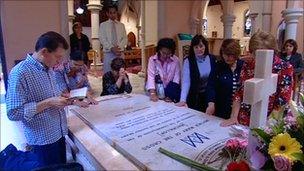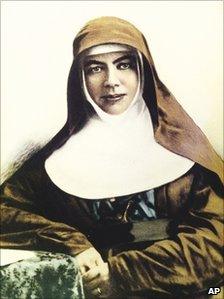Australian saint a symbol of justice for the abused
- Published

Faithful Catholics and victims of sex abuse are both claiming Australia's first saint as their own
Feisty, anti-authoritarian, a lover of the bush, a friend of Aborigines and a champion of a "fair go" for the needy.
Were Australians to come up with the qualities they most wanted in their first saint, many would find themselves describing Sister Mary MacKillop.
But while faithful members of the Catholic Church in Australia are claiming her as their own, victims of clerical abuse say she should become their patron saint.
The daughter of Scottish immigrants, who was born in Melbourne in 1842, she devoted her early life to teaching children in the small South Australian community of Penola, where she came to be regarded as something of an educational pioneer.
It was in Penola that she also founded an order of nuns, Sisters of St Joseph of the Sacred Heart, who were dedicated to helping the poor and opening up more schools in the bush.
Pilgrimage
Some of Australia's five million Catholics believe that Sister Mary MacKillop has miraculous healing powers, which is why she is being canonised in Rome on Sunday (17 October).
The Vatican credits her with two miracles, the second of which was the cure of a woman suffering from terminal cancer, who prayed to Sister Mary every day and who carried a small portrait of her wherever she went. Doctors were unable to explain her unexpected recovery.
All week, pilgrims have been converging on the chapel and museum at the site in North Sydney where she died. They have been kneeling at her tomb, brushing their fingers lightly over her enigmatic portrait and paying homage to her life and memory.
Never before has the gift shop at Mary MacKillop Place done a more flourishing business, with pilgrims queuing up to buy freshly minted St Mary MacKillop T-shirts, candles, postcards, pens, and even fridge magnets.
"She was very Australian," says Sister Monica Cavanagh. "Very feisty and very tough. She certainly knew how to hold her ground - perhaps a bit of her Scottish heritage was coming out there - and when there was an important issue on the table, she stood up for the justice of that situation."
For five months in 1871 and 1872, Mary MacKillop was excommunicated from the Roman Catholic Church, and there is evidence to support the claim that it was because of her part in the exposure of a priest accused of abusing children in a parish north of Adelaide.

Sister Mary MacKillop was briefly excommunicated from the Church
"It's a nasty footnote to a heroic story," according to Father Paul Gardiner, who led the campaign for her canonisation.
"I don't think media people should take it as though it's the main story, particularly since they've got a lot of closer, modern scandals occurring in the Catholic Church to concentrate on.
"Why tarnish the occasion of Mary's canonisation with this miserable bit of scandal?"
Sex abuse victims
But in the run-up to her canonisation, Australian victims of sex abuse at the hands of members of the Catholic priesthood have seized upon the story to claim Mary MacKillop as their own.
Carole Neilsen's son was allegedly abused by priests at a Catholic boarding school in rural New South Wales, and she views Mary MacKillop as much as a heroine as a saint.
"In a way, it's a godsend," she says. "It's a person that we can look to and rally behind to look for the justice and the compassion that the Church should be showing now. And I think victims all around the world are going to be claiming St Mary MacKillop as the patron saint of people abused by priests."
So the defenders of the Church and its fiercest critics are both trying to appropriate Australia's first saint: a long-time symbol of hope for the infirm, and a newfound symbol of justice for the abused.
- Published10 October 2010